How many times have you looked at the stained glass windows and wondered what the symbols in these windows mean?
What can we find in these windows? Through these windows we find the basics of our Catholic faith – the articles of Catholic faith. This list of twelve articles mirrors the Apostles’ Creed, a prayer that sets our Catholic tenets. We will add one window each week.
Stained Glass windows are so beautiful that they can stop us in our tracks captivating us with their special illuminating beauty. In the Middle Ages when few could read or write, stained glass windows through depictions of God, Jesus, the Holy Spirit, saints and religious narratives served as sources of knowledge for our faith. These windows in a stunning way say: This is who we are. Stained glass windows through their beauty can try to extend the wonder of God’s creation in nature. The massive stained glass rosettes in many churches are examples of this affect. Other windows try to emulated scared pictures, and still others, like ours at St Polycarp, use Christian symbols to tell a story. There are a number of themes presented in our windows but the primary one is a step by step visual presentation of the Apostles Creed. Our other themes include the author’s of our Gospels, Saint Polycarp, our diocesan coat of arms and of beauty of baptism and penance and Jesus ‘s love of children.
 Window 1 / Article 1 :
Window 1 / Article 1 :
“I believe in God, the Father almighty, creator of heaven and earth” is the first affirmation of the Apostle’s Creed and the most fundamental item. This article speaks of man and the world in relation to God.
Symbols:
Hand Of God – God reveals His name by handing it down to become more accessible, intimate, and personnel.
Sun & Sky/Green Land & Blue Sea – God created the heavens (Sun & Sky) and the earth (Green Land & Blue Sea). The creation is the culmination of “all God’s saving plans” and the “beginning of the history of salvation” that culminates in Christ (#280 – Catechism of the Catholic Church). “The earth” is the world of men, while “the heavens” represents eschatological glory (the Father in heaven and the saints and angels that surround God).
Trinity/Triangle – The faith of all Christians rests on the Trinity. God revealed Himself as Father, Son, and Holy Spirit.

Window 2 / Article 2 :
“And in Jesus Christ, His only Son, our Lord”. Jesus in Hebrew means “God saves”. Christ comes from the Greek translation of the Hebrew “Messiah” which means “anointed”. Lord indicates divine sovereignty. Jesus was sent to save all mankind from their sins.
Symbols:
Chi Rho – are the first two Greek letters for Christ.
Alpha and Omega – There is no limit to time with Christ.
Circle – There is no end in a circle, just as there is no limit to what Christ can do.
Safe in our Ship – If we believe in Jesus Christ and obey His commands, we will be safe or saved from our sins.
 Window 3 / Article 3 : “He was conceived by the power of the Holy Spirit and was born of the Virgin Mary.” The Annunciation of Mary begins the fullness of time…the fulfillment of God’s promises and preparations.
Window 3 / Article 3 : “He was conceived by the power of the Holy Spirit and was born of the Virgin Mary.” The Annunciation of Mary begins the fullness of time…the fulfillment of God’s promises and preparations.
Symbols:
The Spirit as a Dove – This is one of the images of the Holy Spirit.
Rays of Conception – The Annunciation of Mary through the power of the Holy Spirit will come upon you.
MR and Crown – This represents Mary as the Mother of God.
Cradle or Creche – This represents the birth of Jesus Christ in a stable.
Cup– This represents His coming to us in the Holy Eucharist as His Body and Blood.
 Window 4 / Article 4: “Jesus Christ suffered under Pontius Pilate, was crucified, died and was buried.” God’s saving plan was accomplished “once for all” through the death of his Son, Jesus Christ.
Window 4 / Article 4: “Jesus Christ suffered under Pontius Pilate, was crucified, died and was buried.” God’s saving plan was accomplished “once for all” through the death of his Son, Jesus Christ.
Symbols:
Cross – “Christ died for our sins in accordance with the scriptures” (#619- Catechism of the Catholic Church).
Circle – Jesus came full circle from His birth, through His life and then His death.
Flames –The flames represent the dead Christ’s descent into hell. (Article 5)

Window 5 / Article 6
Article 6: “He ascended into heaven and is seated at the right hand of the Father.” Christ’s ascension into heaven marks the definitive entrance of Jesus’ humanity into God’s heavenly domain (Acts 1:11).
Symbols:
Standard and Cross of Resurrection – The lifting up of Jesus on the cross signifies and announces his Ascension into heaven to appear in the presence of God on our behalf.
Paschal Lamb – The lamb represents Jesus’ sacrifice for all of us.
Flames of the Holy Spirit remaining with us – Jesus Christ, having entered into heaven once and for all, intercedes for us as the mediator who assures us of the outpouring of the Holy Spirit (#667- Catechism of the Catholic Church).
Spring Flower of New Life – Jesus precedes us into the Father’s kingdom, so that we may live in the hope of one day being with Him.
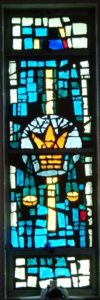
Window 6 / Article 7:
Article 7: “From thence He will come again to judge the living and the dead”. Jesus Christ possesses all power in heaven and on earth.
Symbols:
Royal Crown – Christ’s reign is yet to be fulfilled when He returns to earth with power and great glory. His reign is still under attack by the evil powers of sin. We, His people, await the revelation of the sons of God.
Scales of Good and Evil – At the end of the world (Judgement Day), Christ will come to achieve the ultimate triumph of good and evil. Every man will be judged according to his works (his acceptance or refusal of grace).
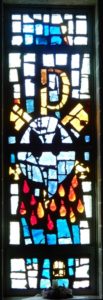 Window 7 / Article 8, 9, and 10:
Window 7 / Article 8, 9, and 10:
Article 8: “I believe in the Holy Spirit” – From the beginning to the end of time, whenever God sends His Son, he always sends His Spirit: their mission is conjoined and inseparable (# 743 – Catechism of the Catholic Church).
Article 9: “I believe in the Holy Catholic Church” – The Church is, in a phrase used by the Fathers, the place “where the Spirit flourishes” (# 749 – Catechism of the Catholic Church).
Article 10: “I believe in the forgiveness of sins” – It was when He gave the Holy Spirit to His apostles that the risen Christ conferred on them His own divine power to forgive sins (# 976 – Catechism of the Catholic Church).
Symbols:
Christ and the Crossed Keys of Heaven – [The Church] has received the keys of the Kingdom of heaven so that, in her, sins may be forgiven through Christ’s blood and the Holy Spirit’s action (# 981 – Catechism of the Catholic Church).
The Holy Spirit as a Dove with Tongues of Fire – In the form of tongues “as of fire”, the Holy Spirit rests on the disciples on the morning of Pentecost and fills them with Himself. The symbolism of fire is one of the most expressive images of the Holy Spirit’s actions (# 696 – Catechism of the Catholic Church).
 Window 8 / Articles 11 and 12:
Window 8 / Articles 11 and 12:
Article 11: “I believe in the Resurrection of the Body” – We firmly believe, and we hope that, just as Christ is truly risen from the dead and lives forever, so after death the righteous will live forever with the risen Christ and He will raise them up on the last day (# 989 – Catechism of the Catholic Church).
Article 12: “I believe in life everlasting” – The Christian who unites his own death to that of Jesus, views it as a step towards Him and an entrance into everlasting life (# 1020 – Catechism of the Catholic Church).
Symbols:
Christogram “IHS” – “IHS” is the Greek abbreviation for Jesus.
Billowing Clouds – This represents Jesus’ Resurrection from earth into heaven.
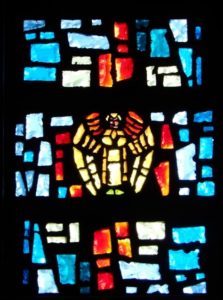
Matthew – An Angel
Matthew was one of the early followers and an apostle of Jesus. The New Testament records that as a disciple, he followed Jesus, and was one of the witnesses of the Resurrection and Ascension of Jesus. The Gospel of Matthew is anonymous: the author is not named within the text, and the subscription “according to Matthew” was added sometime in the second century. Matthew is often depicted in Christian art with one of the four living creatures of Revelation 4:7. The one that accompanies him is in the form of a winged man.
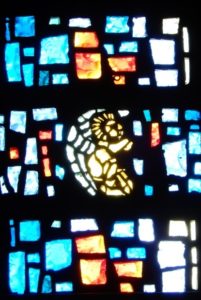
Mark – Winged Lion
Somewhere on the way to Antioch, Peter encountered Mark and took him as a travel companion and interpreter. Mark the Evangelist wrote down the sermons of Peter, thus composing the Gospel according to Mark, before he left for Alexandria. Mark is symbolized by a lion – a figure of courage and monarchy. Some Christian legends say that he was thrown to the Lions and the animals refused to attack or eat him.
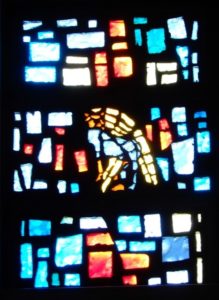
Luke – Winged Ox
The early church fathers ascribed to him authorship of both the Gospel according to Luke and the book of Acts of the Apostles, which would mean Luke contributed over a quarter of the text of the New Testament, more than any other author. He is thought to have been both a physician and a disciple of Paul. Saint Luke is often accompanied by an ox or bull, usually having wings.
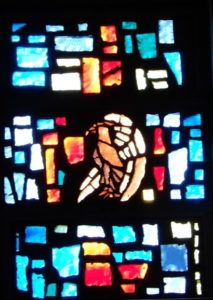
John – An Eagle
Christian tradition says that John the Evangelist was John the Apostle. The Apostle John was a historical figure, one of the “pillars” of the Jerusalem church after Jesus’ death. The saint is symbolically represented by an eagle, one of the creatures envisioned by Ezekiel (1:10) and in the Revelation of John (4:7).
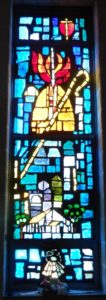
Saint Polycarp
Polycarp is regarded as a saint and one of three Apostolic Fathers. HIs name means “much fruit” in Greek. He is among the earliest Christians whose writing survived. Polycarp may have been the one who compiled, edited, and published the New Testament. All of this makes his writings of great interest. (Check the St. Polycarp website for more details on his life).
Symbols: Flames of Martyrdom in Smyrna, Turkey – Polycarp was a second century Christian bishop of Smyrna. According to the “Martyrdom of Polycarp”, he died a martyr, bound and burned at the stake, then stabbed when the fire failed to touch him.
Bishop’s Mitre and Crosier – Saint Jerome wrote that Polycarp was a disciple of John and that John had ordained him bishop of Smyrna. The mitre is the bishop’s “headdress” and the crosier is his staff.
Our Church Building – The present St. Polycarp Church in Smyrna. Delaware.

Diocese of Wilmington, Delaware – Coat of Arms
The Most Reverend William Francis Malooly is the ninth Bishop of Wilmington. Each bishop has a particular coat of arms.
Symbols: Lion of Judah who is Christ in Revelations – The lion of the tribe of Judah, the root of David is in Revelations (5:5). These are the messianic titles applied to Christ to symbolize His victory.
The Crosses of Calvary – Looking at the three crosses of Calvary, we should learn what our own attitude to our own cross will be and what will result if we (1) reject it as did the bad thief, (2) accept it as the good thief did, or (3) embrace it with Jesus.
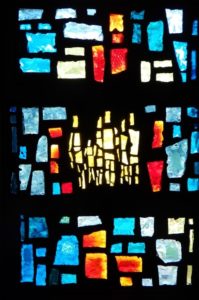
Saint Polycarp – Infant Room
“Let the little children come to me” – In Luke’s Gospel, Chapter 18:15-17, Jesus calls the children to come to Him and do not prevent them for the kingdom of God belongs to such as these. In Matthew’s Gospel, Chapter 19:13-15, Jesus calls the children to Him and places His hands on them.
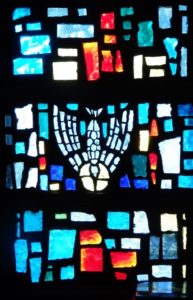
Saint Polycarp – Reconciliation Room
“In Him you have been baptized” – There are many places in the Bible that talk about the necessity of Baptism. For example, in Acts 2:38, “And Peter said to them, ‘Repent, and be baptized every one of you in the name of Jesus Christ for the forgiveness of your sins; and you shall receive the gifts of the Holy Spirit’”.